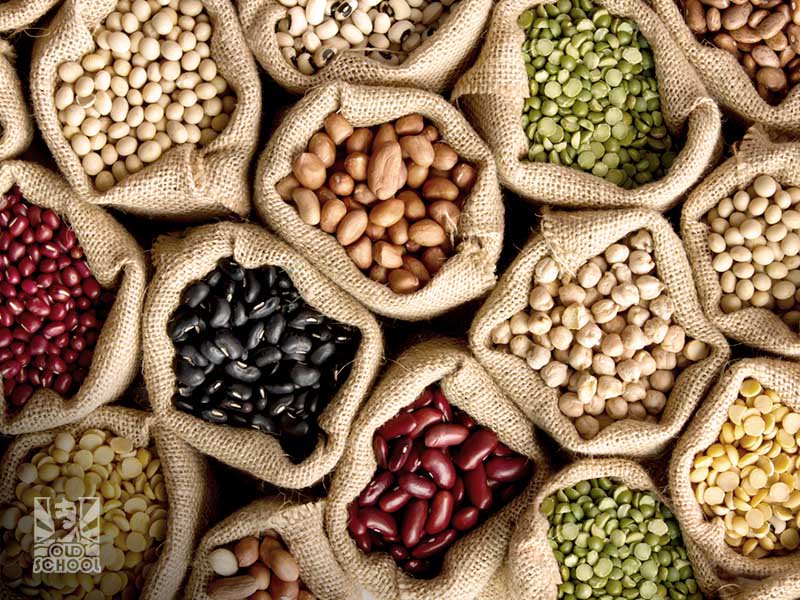
How Much Sodium Per Day is Healthy?
Key Takeaways
- Many Americans eat too much sodium each day. Men in their 20s and 30s eat as much as twice the recommended amount.
- There are several steps you can take to reduce your sodium intake, which we’ve included here.
- Reducing your sodium intake can lower blood pressure and reduce the risk of heart disease and stroke.
Not many people think much about the different minerals that are in their food.
When you eat, do you just worry about fat, protein and carbs? Or do you think about minerals like sodium and potassium?
Have you struggled with bloating and water retention, but you aren’t sure why? Too much sodium might be the answer.

One of the tricks bodybuilders in the Golden Era used to cut before a competition was to reduce sodium intake. It worked better for some, like Frank Zane, than for others, like Samir Bannout.
Just because you work out a lot or are weight training doesn’t mean you need to up your sodium intake.
If you aren’t tracking your sodium levels, you might be getting way too much on a daily basis. Not tracking your food and paying attention to your mineral intake could be derailing your goals.
Today, we’re going to discuss recommendations for daily sodium intake, no matter your activity level. We’ll also discuss ways to reduce your sodium intake and the health benefits.
First, let’s take a look at why sodium and salt aren’t the same and why it matters.
Sodium and Salt: What’s the Difference?
Some people use the terms sodium and salt interchangeably, but they are actually two different things.
Sodium is a naturally occurring mineral in some foods and can also be used during the manufacturing process. It can be used to preserve the product and enhance the taste. Sodium is also an electrolyte, or mineral that our body produces naturally.

Sodium is removed from our bodies in two ways: through sweating and urination. Our kidneys work to filter out excess sodium through our urine.
Most often, sodium is replenished in athletes and weight lifters through electrolyte additives, like sports drinks or supplements. Mixed with a water base, the electrolytes provide the minerals you lose through exercise and activity.

Salt is made up of sodium and chloride. Regular table salt is a mixture of 40 percent sodium to 60 percent chloride.
Salt is a naturally occurring mineral that is mainly derived from seawater or mined from salt flats. When processed, table salt has an anti-caking agent added to reduce clumping and hardening. It also usually contains the trace element iodine to help reduce iodine deficiency.

This mineral is also one of the five basic tastes, which also includes:
- Sweetness
- Bitterness
- Sourness
- Umami
Many people crave salty foods because of this, which increases their overall daily sodium consumption.
Do you know how much sodium you should be having in a day for a healthy diet?
How Much Sodium Should You Have in a Day?
According to the 2015 – 2020 Dietary Guidelines for Americans, you should aim for less than 2,300 mg per day. That means you should be consuming no more than 2.3 grams of sodium in a day.
Do you know how much sodium is in a teaspoon of salt? 2,300 mg of sodium is a teaspoon of regular table salt.

According to these same guidelines, the average American consumes 3,400 mg of sodium per day. This is mainly due to a few factors:
- Not checking nutrition labels
- Eating larger portions than necessary
- Eating too many processed foods
- Adding salt to food when it’s not needed
In fact, processed and pre-made foods account for as much as 75 percent of your daily value of sodium.
Too much sodium is linked primarily to high blood pressure. People who have high blood pressure are also at increased risk of heart disease and stroke.

Due to the high number of health concerns linked to too much sodium consumed in a day, it should be limited. The American Heart Association (AHA) recommends reducing daily sodium intake to just 1,500 mg per day. That’s about ⅔ teaspoon of salt.
Now, these numbers are for the average American. But most OSL readers are not average and require more to replenish the sodium lost during exercise.

So, does that mean you should be consuming more daily value of sodium? Let’s take a look.
1. Does Working Out Regularly Make a Difference?
For most people, consuming more sodium in a day isn’t the answer. Why?
Men in their 20s and 30s consume the most amount of sodium, even more than the average American. Curious to know how much more?
Upwards of 4,200 mg of sodium in a day!
Now, of course, some of that sodium is being depleted through sweat and urination. And if you are a man who sweats more than average, you might lose more. But does that mean you need to increase your daily sodium intake?
Most likely, no. Given what we’ve learned so far, the average OSL reader is consuming more sodium than the average American.

So even if you are working out each day, you likely don’t need to increase your sodium intake.
But let’s say you work manual labor for eight or more hours a day, then hit the gym. And you are one of those lucky super sweaters, who just drip sweat and soak one or two shirts a day.
Depending on the actual amount you consume, you might need to increase your sodium intake. However, before you do that, you need to know how much you are actually consuming on a regular basis.
This is where you need to put in the work. Keep reading to see how to figure out your daily sodium intake to see if you need to make changes.
2. What if I Have High Blood Pressure?
If you have high blood pressure (HBP), you are not alone. Nearly half of all American adults have high blood pressure, according to the AHA.

Even more alarming, only about one in five people get enough exercise, equivalent to 30 minutes five times a week.
What’s the number one killer of people in the United States? Heart disease.
What can we do to change these numbers? Get more exercise and eat a healthier diet.
We’re going to provide some general tips for reducing sodium intake below, but here are some specific to HBP.
3. Quit Smoking
If you are a smoker, now is the time to quit. Smoking increases the risk of heart-related conditions, obesity, and cancers.

In addition, smoking also restricts the blood vessels, causing the heart to pump harder. This increases the risk of high blood pressure for smokers.
We don’t really think many of our readers are smokers, but if you are, please consider making the change. The money saved in cigarettes will easily pay for the increase in your grocery bill for your lower sodium diet.
4. Consider the DASH Diet
The DASH diet stands for Dietary Approaches to Stop Hypertension. It’s a lifestyle change that has shown promising results.
In a trial following 412 adults, some were eating the Standard American Diet while others were following the DASH diet. The group was divided between three different initial sodium levels:
- High daily sodium intake = 3,600 mg or more
- Medium daily sodium intake = 2,300 mg or more
- Low daily sodium intake = 1,500 mg or more
Of those who ate the DASH diet, blood pressure readings lowered more than the SAD diet for all three groups. The study noted that those who lowered the sodium intake on the DASH diet had the best readings.

Foods included in the DASH diet:
- Whole grains
- Vegetables
- Fruits
- Fat-free or low-fat dairy
- Lean meats
- Poultry
- Fish
- Nuts
- Seeds
- Legumes
- Healthy fats

How much sodium should you have per day if you have high blood pressure? Try to stick to the low end, around 1,500 mg or less.
Following the link above you can find the calorie and serving recommendations based on age and activity level. Give it a try for a month and see how your blood pressure levels change.
5. Get More Potassium
Increasing your potassium intake can actually counter the effects that sodium has on your blood pressure.
To get your daily allotment of potassium, you should have between eight and ten servings of fruits and vegetables. That sounds like a lot, but a serving is only half cup to a cup.

Not sure what potassium-rich foods are? Here’s some to add to your grocery list:
- Whole grains
- Nuts
- Spinach
- Oranges
- Cantaloupes
- Tomatoes
- Sweet potatoes
- Dried apricots
- Bananas
Did you know that just one cup of cooked spinach has as much as 800 mg of potassium?
To get enough in your diet, aim for 3,500 – 4,700 mg of potassium per day.
If you aren’t sure what your sodium and potassium intake are on a daily basis, we’ll help you figure out. Then, we’ll offer tips on how to get your sodium levels down if they are too high.
How Much Sodium Are You Consuming in a Day?
You’ll need to do a few different things to determine how much sodium you are actually getting each day.
First, if you aren’t already, you need to check nutrition labels on the food you are eating. All nutrition labels are required to list the sodium content per serving, so this is easy to do.

It’s a little bit harder to do that on whole foods that don’t include a nutrition label. Let’s take a look at some foods you might be eating, and what their sodium content is.
- 1 large egg – 52 mg
- 3 oz frozen shrimp – 200 – 800 mg
- 3 oz fresh shrimp – 100 mg
- 1 cup of canned soup – 700 mg
- 3 oz cured ham – 1,110 mg
- 8 oz pre-packaged beef broth – 780 mg
- 1 serving broccoli – 49 mg
- 1 medium banana – 1 mg
These numbers are approximate and from the U.S. Food and Drug Administration (USDA). As you can see, the sodium content of whole foods like an egg or banana is significantly less. Packaged and processed foods like ham and canned soup are much higher in sodium.

Clinical Study
In a study done in 2009 on over 8,000 packaged foods sold in the U.S., the FDA provided some surprising results. More than half the products that had a “healthy” claim label exceeded the limits of the label claim. This was based on the 2,300 mg daily limit which has since been lowered to 1,500 mg.
This study just goes to show how important it is to read ingredient and nutrition labels. Relying just on the front of the product label doesn’t give you the full value of the product.
Were you surprised by the sodium content in some foods or the results of the FDA study? Let’s see what types of foods are the worst offenders with the highest sodium.
Top Ten Worst Offenders
According to the CDC, there are ten foods that make up 40 percent of our daily intake of sodium.

These are the worst offenders that don’t always have a salty taste and might surprise you:
- Pizza
- Sandwiches
- Breads, rolls
- Cured meats, cold cuts
- Burritos, tacos
- Soups
- Salty snacks – chips, popcorn, pretzels, crackers
- Chicken
- Cheese
- Omelettes
Surprised by the foods on this list? Ready for some tips on how to reduce your sodium intake per day?
Tips to Reduce Your Sodium Intake Per Day
After you start tracking your sodium intake, you might find that you are consuming too much in a day. If so, here are some tips that can help reduce your sodium levels.
1. Eat Whole Foods
As you can see from our list above, whole, unprocessed foods typically contain much less sodium. When in doubt, choose a whole food option over a packaged and processed one.

A whole foods diet consists mostly of:
- Nuts
- Legumes
- Seeds
- Fruits
- Vegetables
- Whole grains
- Lean meats
- Plant-based protein
2. Track Your Foods

People who work out regularly and have fitness goals tend to track their meals more than the average American. If you are already doing so, that’s great! You should have an idea of what you are eating and how much of that is sodium per day.
If not, you should be. Then you’ll have an idea of what you are putting in your body and where you can stand to improve.
Plus, tracking your food teaches you how much sodium is in the food you’re eating, helping you make better choices.
3. Read Nutrition Labels
We covered this already, but we wanted to make sure we said it again. Make sure to read nutrition labels on all the foods you buy that have them.
Pay special attention to serving sizes and sodium content in mg, and not so much the daily value percentage. Unless you are eating a 2,000 calorie diet, the percentage won’t be accurate.
If you are eating whole foods and aren’t sure about the nutrition content, the food tracker app can help.
You can also use the USDA link we provided above to find the right information as well.
4. Prepare Your Own Food
The more you prepare your own food, the more you control what goes in it.
Relying less on premade sauces and mixes, and saying no to prepackaged foods will help reduce your sodium intake.
If you like to use salt for flavor, opt for no-salt seasoning blends and spices instead. They’ll add flavor without the added sodium.
5. Buy Fresh, Not Frozen
A lot of frozen products, like seafood and veggies, have added salt to preserve the food and flavor.

By purchasing fresh food, you can reduce your sodium intake. And you can always freeze your produce and seafood yourself if you buy more than you need. That way, you can do so without adding any more salt.
6. Portion Control
Most Americans eat too much per meal already. Master portion control and automatically reduce the sodium content.
If you’re going out to eat, consider sharing with someone or take half the meal home to eat another time.

A lot of restaurants are providing nutrition content on their menus already. But if you dine out and they don’t, ask your server before you make a meal choice.
You can also ask to not have salt added, or have sauce and dressing on the side. That way, you can control the amount used, instead of letting the cook make the decision for you.
7. Choose the Lower Sodium Option
Sometimes, it’s unavoidable to buy some pre packaged foods. Many packaged products offer a low sodium alternative. When your shopping, scan all the choices before you make a decision.

If you are looking for nuts or seeds, make sure you get the package that doesn’t have salt added. Buying premade broth or stock? Then choose the low sodium option, which has as much as 25 percent less sodium than the alternative.
8. Know Your Labels
Now more than ever, there are so many things to pay attention to when it comes to labeling.
Just like you can be fooled by so called healthy label claims, you can also find trigger words that can signal better choices.
Here are some things to keep an eye out from when you’re shopping:
- Low sodium – 140 mg or less per serving
- Very low sodium – 35 mg or less per serving
- Reduced sodium – 25 percent or less than the normal product
- Light in sodium/lightly salted – 50 percent or less than the normal product
- No salt added/unsalted – no salt has been added when processed, but this does not mean the product is salt/sodium free

There are also other terms on labels that mean there is sodium or added salt in the product. Be on the look out for:
- Baking powder
- Baking soda (sodium bicarbonate)
- Sodium alginate
- Disodium phosphate
- Sodium nitrite
- Monosodium glutamate (MSG)
- Sodium nitrite
When in doubt, opt for choices with 200 mg or less per serving. And don’t forget to factor in the serving size when reading the labels!
9. Rinse Your Products

Sometimes it’s unavoidable to buy canned vegetables or beans. Instead of going without, take the time to rinse the products before you use them.
You can even do this with canned fish, like tuna, to lower the amount of sodium you ingest. Small changes can add up to a big difference in how much sodium per day you’re eating.
The Bottom Line
Reducing your sodium intake can have positive health effects. Remember, lowering your sodium levels can:
- Reduce your risk of heart disease or stroke
- Eliminate or reduce high blood pressure
- Reduce bloat and water retention
- Reduce your taste for sodium over time
By taking charge of how much sodium you have per day, you can improve your overall health. As we age, it gets harder and harder to change our habits.
The sooner you start lowering your sodium levels, the sooner you’ll lose the desire for salty foods. That makes it easier to make healthier choices and say no to added salt and preservatives.
Stay tuned for our article coming up, where we’ll talk all about a low sodium diet plan.
Do you know your sodium numbers? Were you surprised by some of the stats we provided today? Do you have any other tips to offer that we didn’t? Let us know in the comments below!











